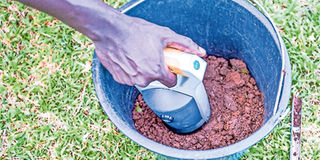Agronomist Notebook: Here’s how to interpret soil test results

Plant nutrient uptake is affected by various factors such as soil moisture content, soil temperature, soil pH and the physical soil condition such as if compacted and the availability of other elements. FILE PHOTO | NATION MEDIA GROUP
What you need to know:
- In some cases, the nutrients get leached beyond the plant's root zone or are washed away by running water and deposited to the water catchment areas.
- Plant nutrient uptake is affected by various factors such as soil moisture content, soil temperature, soil pH and the physical soil condition such as if compacted and the availability of other elements.
- For the farm to be productive, the farmer should ensure the soil is providing an optimal environment for the crops.
- The good news is that many farmers these days conduct a soil test analysis. However, the biggest challenge comes when interpreting the soil test results.
Soils lose most of their nutrients in various ways, which include overcultivation, erosion and burning of farm waste.
In some cases, the nutrients get leached beyond the plant's root zone or are washed away by running water and deposited to the water catchment areas.
The use of salty water for irrigation sometimes makes the soil nutrients not available to the plant due to the high/low soil pH.
Therefore, there is need for farmers to manage the pH levels of their water and the soil to slightly acidic for optimum growth of crops.
However, the availability of the nutrients in the soil does not guarantee that the plants will absorb them.
Plant nutrient uptake is affected by various factors such as soil moisture content, soil temperature, soil pH and the physical soil condition such as if compacted and the availability of other elements.
Presence of one nutrient in the soil prevents the uptake of the other, what is technically referred to as antagonism.
For the farm to be productive, the farmer should ensure the soil is providing an optimal environment for the crops.

Sample soil test for a farmer planting onions. TABLE | COURTESY
There are 14 nutrients required by the plant for growth, and they are broadly classified as macro and micro. The plant requires macronutrients (nitrogen, phosphorus, and potassium) in large quantities while the micronutrients are needed in small quantities.
To achieve good yields, nutrient balance between micro and macro nutrients has to be maintained. In case of imbalance, this results in deficiencies, toxicities, or interference of one nutrient with the absorption of others.
INTERPRETING THE SOIL TEST RESULTS
This may lead to the stress of the crops, causing a decrease in quality and yield.
In most cases, farmers estimate the amount of fertiliser to be applied to the crop using the general recommendations.
However, for accuracy and to be cost-effective, soil test analysis is critical because it guides the farmer in making a fertiliser programme.
The good news is that many farmers these days conduct a soil test analysis. However, the biggest challenge comes when interpreting the soil test results.
The other day farmer Andrew called me lamenting that a certain fertiliser has scorched his crops.

Fertiliser programme for the above soil test analysis. TABLE | COURTESY
He said that he had followed the guidelines from the soil test analysis.
After he sent me the digital copy of the results, I realised that Andrew had applied less fertiliser. The soil test analysis indicated that CAN was supposed to be applied thrice during the growing period of sukuma wiki (collard greens) but he only did it once.
The soil analysis results may show the top soil has very high pH, low nitrogen and low phosphorus. If the soil has low phosphorus, before planting onions, the farmer should use DAP during planting, which should be incorporated in the topsoil about 20cm depth.
During top dressing, Ammonium Sulphate should be applied in two splits, at day 30 and 45.
The tables on the right show a sample soil test and fertiliser programme prepared to solve the problem for a farmer planting onions.





